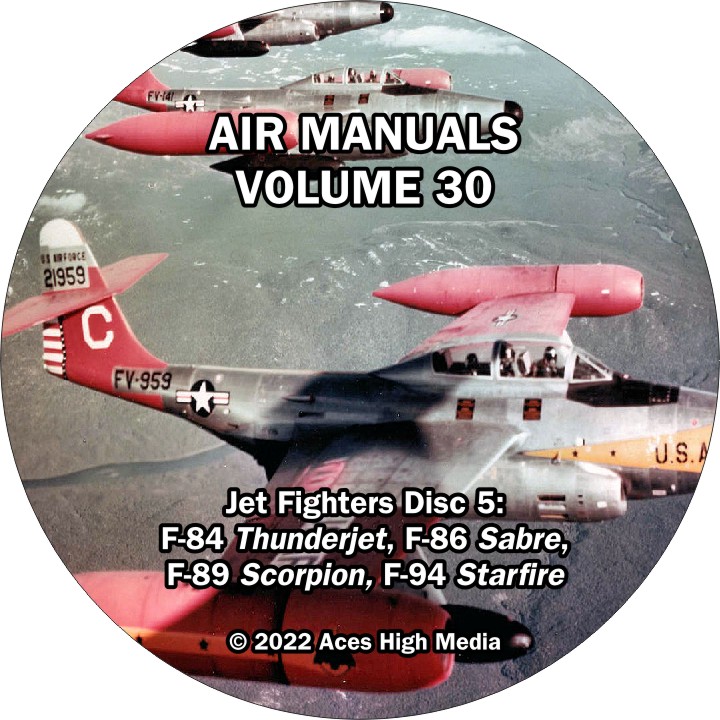Aces High Air Manuals
Volume 30: Jet Fighters Disc 5 - F-84, F-86, F-89, F-94
Republic P-84 and F-84 Thunderjet
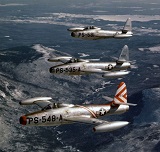
|
Republic P-84 Thunderjet Pilot's Handbook
49 pages
The Republic F-84 Thunderjet was an American turbojet fighter-bomber aircraft. Originating as a 1944 United States Army Air Forces (USAAF) proposal for a "day fighter", the F-84 first flew in 1946. Although it entered service in 1947, the Thunderjet was plagued by so many structural and engine problems that a 1948 U.S. Air Force review declared it unable to execute any aspect of its intended mission and considered canceling the program. The aircraft was not considered fully operational until the 1949 F-84D model and the design matured only with the definitive F-84G introduced in 1951. In 1954, the straight-wing Thunderjet was joined by the swept-wing F-84F Thunderstreak fighter and RF-84F Thunderflash photo reconnaissance aircraft.
|
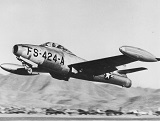
|
Republic F-84B, F-84C, and F-84D Thunderjet Handbook, Flight Operating Instructions
81 pages
The P-84B/F-84B was the first production version. 226 were built. The F-84C reverted to the more reliable J35-A-13 engine and improved fuel, hydraulic, and electrical systems; 191 were built. The F-84 featured the J35-A-17 engine and various structural improvements; 154 were built.
|
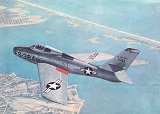
|
Republic F-84F Thunderstreak Flight Handbook
223 pages
The first variant to have swept wings.
|

|
Republic F-84G Thunderjet Flight Handbook
204 pages
Single-seat fighter-bomber capable of delivering the Mark 7 nuclear bomb using the LABS, J35-A-29 engine, autopilot, capable of inflight refueling using both the boom (receptacle in left wing leading edge) and drogue (probe fitted to wingtip fuel tanks), introduced the multi-framed canopy which was later retrofitted to earlier straight-winged F-84s. A total of 3,025 were built (1,936 for NATO under MDAP). The larger engine had a higher airflow at its take-off thrust than the intake had been designed for. This caused higher flow velocities, increased pressure losses and thrust loss. Commencing with block 20, auxiliary "suck-in" doors were added ahead of the wing leading edge to regain some of the thrust loss. At high engine rpm and low aircraft speeds, such as take-off, the spring-loaded doors were sucked open by the partial vacuum created in the duct. When the aircraft reached sufficient airspeed the ram pressure rise in the duct closed the auxiliary doors. F-84G 51-1343 was modified with a periscope system to test the periscope installation proposed for the Republic XF-103.
|

|
Republic RF-84F-5 (and later) Thunderflash Flight Manual
320 pages
715 of the photo-recon version of the F-84F were built.
|
F-86 Sabre
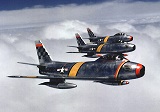
|
F-86K Sabre Flight Manual
320 pages
The North American F-86 Sabre (sometimes called the Sabrejet) was a transonic jet fighter aircraft. Produced by North American Aviation, the Sabre is best known as the United States's first swept wing fighter which could counter the similarly-winged Soviet MiG-15 in high-speed dogfights over the skies of the Korean War. Considered one of the best and most important fighter aircraft in the Korean War, the F-86 is also rated highly in comparison with fighters of other eras. Although it was developed in the late 1940s and was outdated by the end of the 1950s, the Sabre proved versatile and adaptable, and continued as a front-line fighter in numerous air forces until the last active operational examples were retired by the Bolivian Air Force in 1994.
Its success led to an extended production run of more than 7,800 aircraft between 1949 and 1956, in the United States, Japan and Italy. Variants were built in Canada and Australia. The Canadair Sabre added another 1,815 airframes, and the significantly redesigned CAC Sabre (sometimes known as the Avon Sabre or CAC CA-27), had a production run of 112. The Sabre was by far the most-produced Western jet fighter, with total production of all variants at 9,860 units. |

|
Canadair CL-13 (F-86) Sabre Mks 2 & 4 Pilot's Operating Instructions
144 pages
The Canadair Sabre was a jet fighter aircraft built by Canadair under licence from North American Aviation. A variant of the North American F-86 Sabre, it was produced until 1958 and used primarily by the Royal Canadian Air Force until replaced with the Canadair CF-104 in 1962. Several other air forces also operated the aircraft.
|
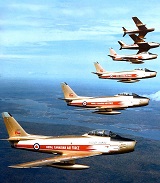
|
Canadair CL-13 (F-86) Sabre 6 Pilot's memo (1958)
71 pages
The Sabre Mk 5 was used by the Golden Hawks demonstration team from 1959 until its disbandment in 1964, and a Mk 3 was used by Jacqueline Cochran to set a new women's speed record (652.5 mph) in 1953. The Sabre Mk 6 was widely regarded as the best dogfighter of its era.
|
Northrop F-89 Scorpion
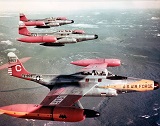
|
Northrop F-89B&C Scorpion Flight Manual
354 pages
The Northrop F-89 Scorpion was an American all-weather interceptor built during the 1950s, the first jet-powered aircraft designed as such from the outset to enter service. Though its straight wings limited its performance, it was among the first USAF jet fighters equipped with guided missiles and notably the first combat aircraft armed with air-to-air nuclear weapons (the unguided Genie rocket).
|

|
Northrop F-89D Scorpion Flight Handbook
400 pages
Main production version which saw deletion of the six 20 mm (.79 in) cannons in favor of 104 rockets in wing pods, installation of new Hughes E-6 fire control system, AN/APG-40 radar and the AN/APA-84 computer. This new system allowed the use of a lead-collision attack in place of the previous lead-pursuit-curve technique. A total of 682 were built.
|

|
Northrop F-89H Scorpion Flight Manual
348 pages
The F-89H version featured the E-9 fire control system, six GAR-1/GAR-2 Falcon missiles and 42 Folding Fin Aircraft Rockets (FFAR). 156 were built.
|
Lockheed F-94 Starfire
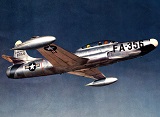
|
Lockheed F-94B Starfire Handbook, Flight Operating Instructions
145 pages
The Lockheed F-94 Starfire was a first-generation jet aircraft of the United States Air Force. It was developed from the twin-seat Lockheed T-33 Shooting Star in the late 1940s as an all-weather, day/night interceptor. The aircraft reached operational service in May 1950 with Air Defense Command, replacing the piston-engined North American F-82 Twin Mustang in the all-weather interceptor role.
|

|
Lockheed F-94 Starfire Flight Handbook
350 pages
The F-94 was the first operational USAF fighter equipped with an afterburner and was the first jet-powered all-weather fighter to enter combat during the Korean War in January 1953. It had a relatively brief operational life, being replaced in the mid-1950s by the Northrop F-89 Scorpion and North American F-86D Sabre. The last aircraft left active-duty service in 1958 and Air National Guard service in 1959.
|
